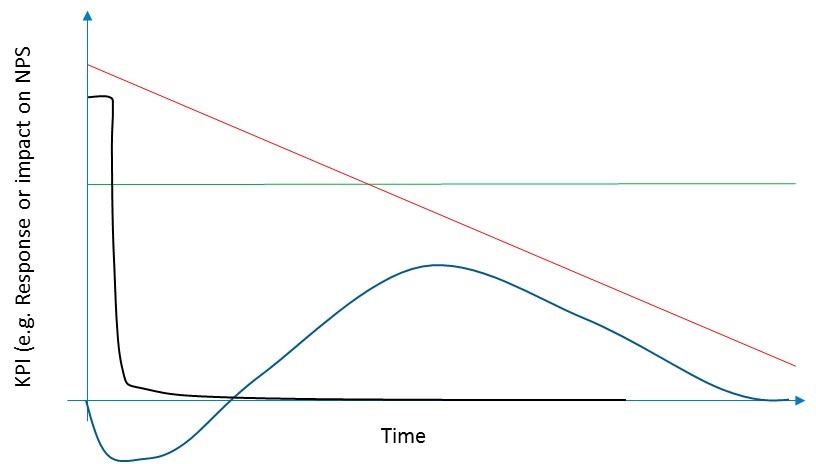I wanted to share some thoughts about when real-time decisioning is actually necessary. I guess the reason for wanting to do this is to balance the view that everything can be actioned by trigger event campaigns executed in real time.
So have a look at the graph below – with the x axis being time, and the y axis being some kind of KPI measure – for example, response (or perhaps the effect on net promoter score).
I’ve drawn four lines on this graph to help make the point:
- The green line – just going flat over time – suggests that sometimes response doesn’t vary much over time. A good example of this would be high-ticket items or a mortgage, perhaps. Realistically – if you send a message to a customer after they have hovered over the mortgage product on your website – it isn’t really going to seal the deal there and then.
- The red line shows that response can drop over time. I’m not sure it’s quite as linear as this, but essentially, this is a case of ”the sooner the better”, and so real-time decisioning is important – but I would argue not essential. It depends on the cost to execute and the overall ROI.
- The black line suggests that real-time execution of a decision is essential – if you don’t act quickly, the moment has gone, as has your customer! This is more akin to perhaps helping a customer who is having difficulty on line – e.g. filling out a form – if you don’t help them immediately, they may go away, never to return. But do show a bit of caution, too. Is the profile more like the blue line?
- The blue shows that if you act too quickly, you may actually destroy responsiveness (or more likely value). Making an offer to a customer on an abandoned cart can come too quickly – equally there are overtones of Big Brother here.
Three ways to determine the best action
So, how do you find out what kind of profile is the most useful for the particular action that you want to take?
Well, first of all, I would just like to give a shout out to marketing nous (i.e., common sense) because in fairness, some of these things can be obvious. For example, if you reduce a customer’s download speed as they approach their limit you help the customer avoid incurring overages – it is clear that more rapid decisioning will result in better responses.
Secondly, the answers are probably in your data. I hear a lot about attrition and churn triggers – such as browsing competitor websites. What could you do? Well, it would be pretty easy to observe when that browsing behaviour occurred and then plot the churn or attrition event out over time. There are probably many natural tests that are sitting in your data right now.
Finally there is multivariate testing. Why not try making that abandoned cart or basket offer at Hour 1/2/3 or Day 1/2/3? That way, you can get a feel for how behaviour varies over time so that you can then make the optimal decision for the customer and your business.
If you want to find out a more about how SAS helps its clients act upon insight, visit the customer intelligence solutions page.

